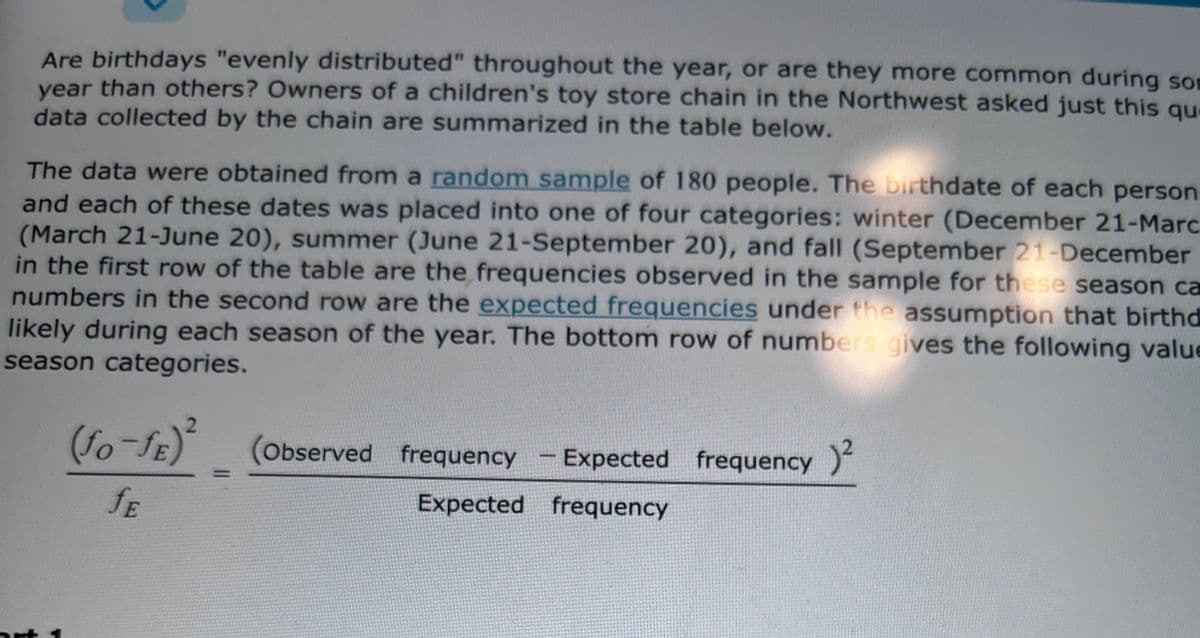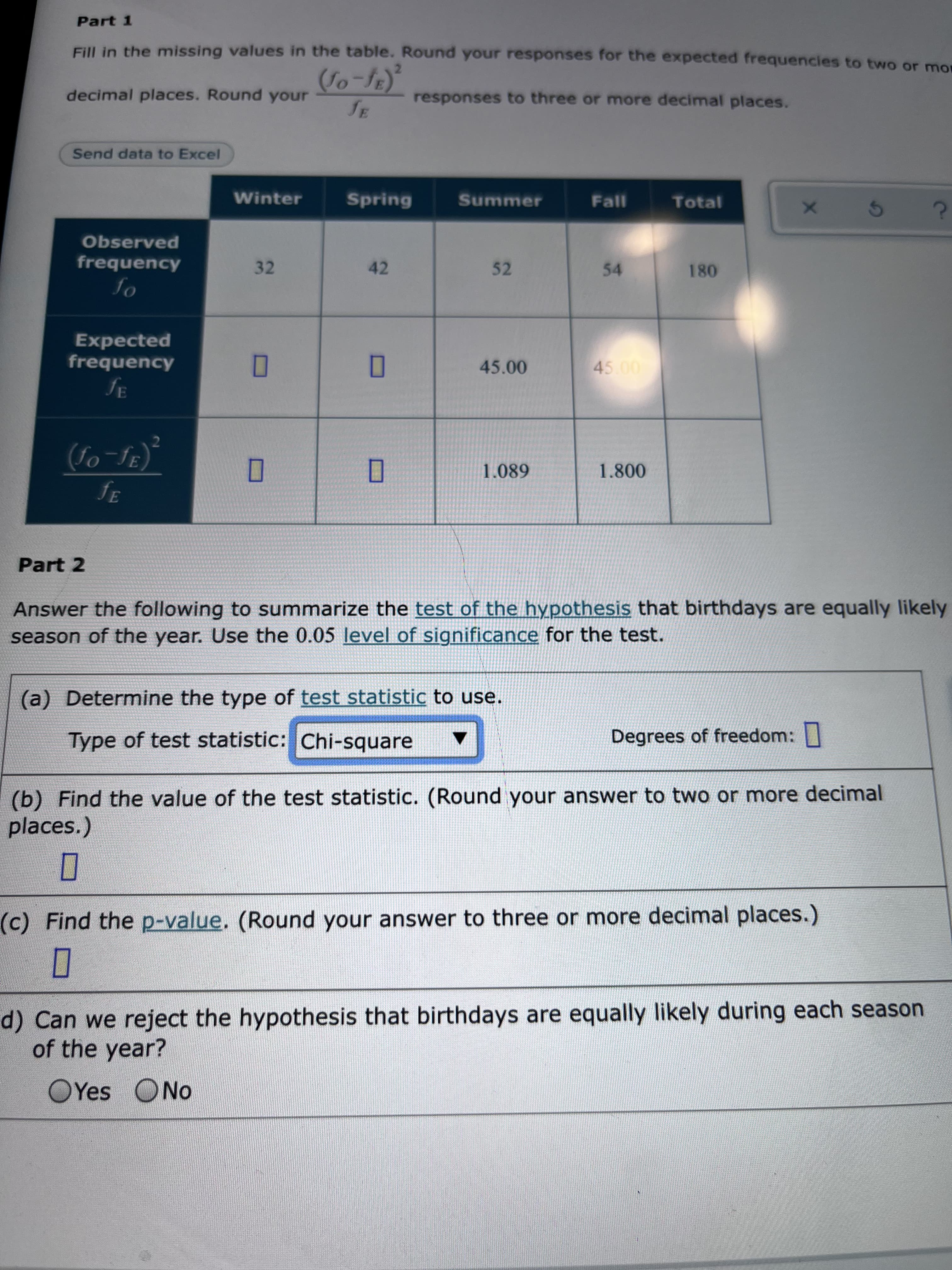Are birthdays "evenly distributed" throughout the year, or are they more common during sor year than others? Owners of a children's toy store chain in the Northwest asked just this que data collected by the chain are summarized in the table below. The data were obtained from a random sample of 180 people. The birthdate of each person and each of these dates was placed into one of four categories: winter (December 21-Marc (March 21-June 20), summer (June 21-September 20), and fall (September 21-December in the first row of the table are the frequencies observed in the sample for these season ca numbers in the second row are the expected frequencies under the assumption that birthd likely during each season of the year. The bottom row of numbers gives the following value season categories. (Observed frequency Expected frequency ) fE Expected frequency Part 1 Fill in the missing values in the table. Round your responses for the expected frequencies to two or mor decimal places. Round your responses to three or more decimal places. Send data to Excel Winter Spring Summer Fall Total Observed frequency 32 42 52 54 081 fo Expected frequency 45.00 00 00 1.089 1.800 Part 2 Answer the following to summarize the test of the hypothesis that birthdays are equally likely season of the year. Use the 0.05 level of significance for the test. (a) Determine the type of test statistic to use. Type of test statistic: Chi-square Degrees of freedom:| (b) Find the value of the test statistic. (Round your answer to two or more decimal places.) (c) Find the p-value. (Round your answer to three or more decimal places.) d) Can we reject the hypothesis that birthdays are equally likely during each season of the year? OYes ONo
Are birthdays "evenly distributed" throughout the year, or are they more common during sor year than others? Owners of a children's toy store chain in the Northwest asked just this que data collected by the chain are summarized in the table below. The data were obtained from a random sample of 180 people. The birthdate of each person and each of these dates was placed into one of four categories: winter (December 21-Marc (March 21-June 20), summer (June 21-September 20), and fall (September 21-December in the first row of the table are the frequencies observed in the sample for these season ca numbers in the second row are the expected frequencies under the assumption that birthd likely during each season of the year. The bottom row of numbers gives the following value season categories. (Observed frequency Expected frequency ) fE Expected frequency Part 1 Fill in the missing values in the table. Round your responses for the expected frequencies to two or mor decimal places. Round your responses to three or more decimal places. Send data to Excel Winter Spring Summer Fall Total Observed frequency 32 42 52 54 081 fo Expected frequency 45.00 00 00 1.089 1.800 Part 2 Answer the following to summarize the test of the hypothesis that birthdays are equally likely season of the year. Use the 0.05 level of significance for the test. (a) Determine the type of test statistic to use. Type of test statistic: Chi-square Degrees of freedom:| (b) Find the value of the test statistic. (Round your answer to two or more decimal places.) (c) Find the p-value. (Round your answer to three or more decimal places.) d) Can we reject the hypothesis that birthdays are equally likely during each season of the year? OYes ONo
Glencoe Algebra 1, Student Edition, 9780079039897, 0079039898, 2018
18th Edition
ISBN:9780079039897
Author:Carter
Publisher:Carter
Chapter10: Statistics
Section: Chapter Questions
Problem 13PT
Related questions
Question

Transcribed Image Text:Are birthdays "evenly distributed" throughout the year, or are they more common during sor
year than others? Owners of a children's toy store chain in the Northwest asked just this que
data collected by the chain are summarized in the table below.
The data were obtained from a random sample of 180 people. The birthdate of each person
and each of these dates was placed into one of four categories: winter (December 21-Marc
(March 21-June 20), summer (June 21-September 20), and fall (September 21-December
in the first row of the table are the frequencies observed in the sample for these season ca
numbers in the second row are the expected frequencies under the assumption that birthd
likely during each season of the year. The bottom row of numbers gives the following value
season categories.
(Observed frequency
Expected frequency )
fE
Expected frequency

Transcribed Image Text:Part 1
Fill in the missing values in the table. Round your responses for the expected frequencies to two or mor
decimal places. Round your
responses to three or more decimal places.
Send data to Excel
Winter
Spring
Summer
Fall
Total
Observed
frequency
32
42
52
54
081
fo
Expected
frequency
45.00
00 00
1.089
1.800
Part 2
Answer the following to summarize the test of the hypothesis that birthdays are equally likely
season of the year. Use the 0.05 level of significance for the test.
(a) Determine the type of test statistic to use.
Type of test statistic: Chi-square
Degrees of freedom:|
(b) Find the value of the test statistic. (Round your answer to two or more decimal
places.)
(c) Find the p-value. (Round your answer to three or more decimal places.)
d) Can we reject the hypothesis that birthdays are equally likely during each season
of the year?
OYes ONo
Expert Solution
This question has been solved!
Explore an expertly crafted, step-by-step solution for a thorough understanding of key concepts.
This is a popular solution!
Trending now
This is a popular solution!
Step by step
Solved in 5 steps

Recommended textbooks for you

Glencoe Algebra 1, Student Edition, 9780079039897…
Algebra
ISBN:
9780079039897
Author:
Carter
Publisher:
McGraw Hill

Holt Mcdougal Larson Pre-algebra: Student Edition…
Algebra
ISBN:
9780547587776
Author:
HOLT MCDOUGAL
Publisher:
HOLT MCDOUGAL

College Algebra (MindTap Course List)
Algebra
ISBN:
9781305652231
Author:
R. David Gustafson, Jeff Hughes
Publisher:
Cengage Learning

Glencoe Algebra 1, Student Edition, 9780079039897…
Algebra
ISBN:
9780079039897
Author:
Carter
Publisher:
McGraw Hill

Holt Mcdougal Larson Pre-algebra: Student Edition…
Algebra
ISBN:
9780547587776
Author:
HOLT MCDOUGAL
Publisher:
HOLT MCDOUGAL

College Algebra (MindTap Course List)
Algebra
ISBN:
9781305652231
Author:
R. David Gustafson, Jeff Hughes
Publisher:
Cengage Learning
